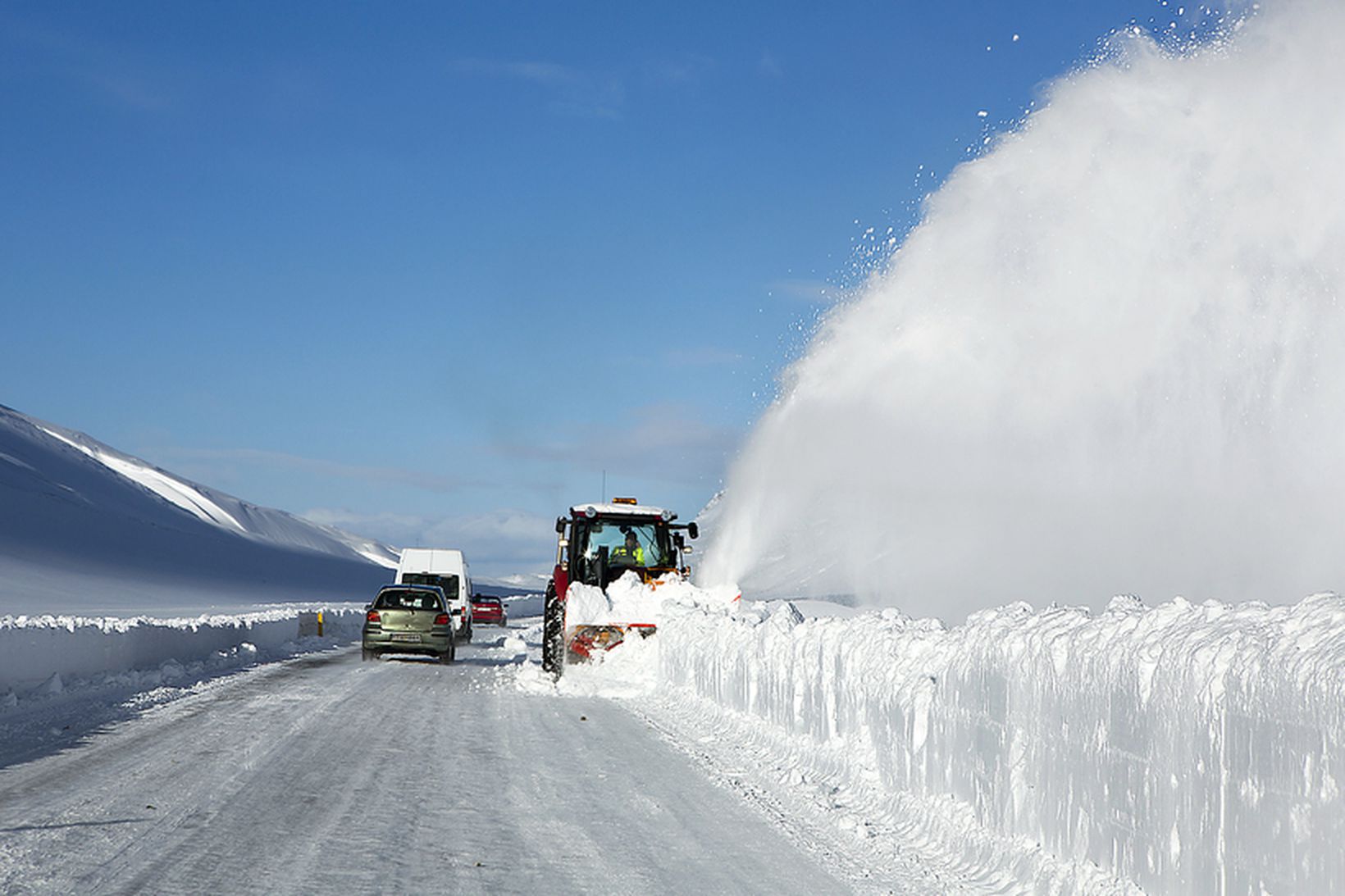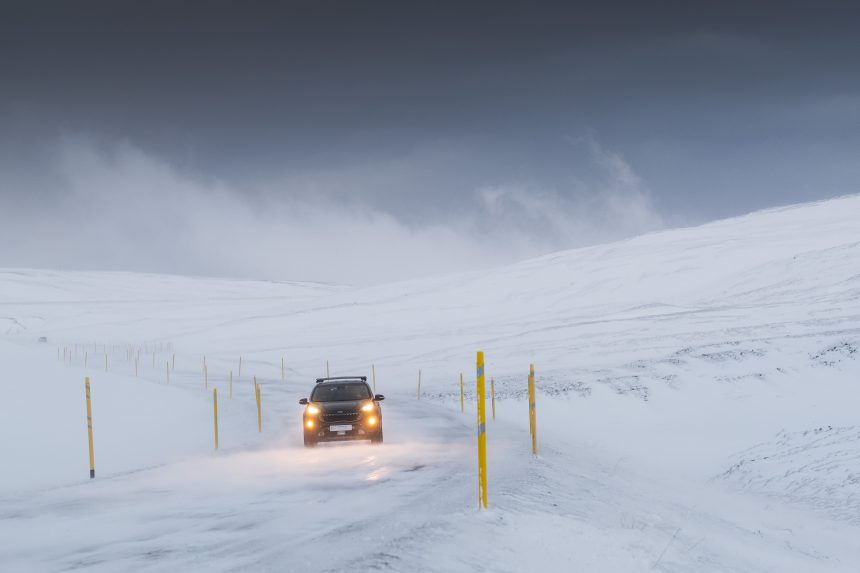Winter driving in Iceland
Explore the hazards of driving on slippery roads, and see some tips and tricks that can help you avoid getting into trouble during the winter time.

Led Zeppelin so elegantly described Iceland as “We come from the land of the ice and snow” in one of their most famous songs which they wrote after the concert they had in Reykjavík in June 1970.
Although Greenland is far from being green, the name “Iceland” says a lot about the weather conditions that you may find in Iceland. Here you can find ice and snow no matter the season. Icy and snowy roads however are mostly present during the winter as one would expect. But how do people get from point “A” to point “B” during the harsh and sometimes extreme conditions of winter that the Icelandic climate will throw at them?
The Icelandic road system is very well-engineered and planned with all weather conditions in mind. Roads are laid with asphalt that is more coarse than would be found in warmer countries to ensure better road grip, crash railings are built in tight turns and on mountain roads to prevent cars from driving off the road if the road is slippery.
The roads are also constantly maintained and monitored, ploughed and salt is spread over the road surface to prevent ice layers from forming.
Even though all these measures are taken to increase the road safety of drivers and pedestrians it does not make the roads 100% safe from the forces of nature. Caution, skill, knowledge, and experience will always need to be applied to ensure your car will not skid off the road or into oncoming traffic.

Know what you are getting yourself into.
During the wintertime it is always a good idea to plan ahead, check the road conditions on the roads you will be driving on, how are they? Are they slippery? How is the visibility? Is the road open or closed? Do I need to find a different path? Should I wait for better weather to drive there? These are all questions that can help you find the best solution for getting to your destination safely, so plan your journey accordingly when driving in harsh winter conditions.
The IRCA (The Icelandic Road and Coastal Administration) offers all the information you need to see weather and road conditions on each road that your path may lead to.
“The weather does not care where and when you booked a trip or a hotel room” -Ingo Smith
Driving on slippery roads.
Driving on slippery roads, be it from water on the roads where the car can lose traction from hydroplaning or losing traction from a layer of ice and snow, can be dangerous and hard. There are many tips that can save you and your passengers from disaster, once a car loses traction or road grip things can go bad fast so quick reactions will need to be taken.
Slowly, but surely.
Driving in Iceland during winter can be a magical experience, the days are short so the Starbright sky is visible most of the day and the northern lights show their magnificence now and again. But don’t let these jawdropping sights distract you from the job at hand, getting safely to your destination. Take your time and don’t be in a rush.
Keep your traction
On slippery roads, traction is your one true friend. Almost all Icelandic residences mount special winter tires or even studded winter tires on their car to ensure better grip, but they also do not make the car accident free so be sure when accelerating to do it slowly and steadily, accelerating too quickly can cause the tires to lose their grip. The same applies for decelerating i.e. braking, do it slowly and carefully, pushing the brakes too hard will cause the car to lose its grip and the car will slide (most cars have Antilock Braking System or ABS to help in situations like that but they will not ensure that you will not slide or have a collision) so brake slowly and evenly to maintain grip and have more distance between you and the car in front of you.
Knowing how the car brakes and handles in snow and ice is also a very important factor when it comes to being confident in driving the ring road in Iceland during winter for example so a good tactic is to test it out: Find a place where there is no traffic (parking area or street with little or no traffic) drive at a slow-ish speed and hit the brakes, with this you can see how the tires and brakes take on the road surface if it slipes or how much it slides and you can continue driving knowing roughly what sort of grip your car has.
It should be apparent to you by now that traction is key. Maintain it, sustain it.
Driving uphill can be worrisome thought for many, but not a problem as long as you maintain a constant speed, if you accelerate too hard when driving uphill to gain speed the car can lose traction. Also stopping the car in an incline is not a good idea as it will be hard for the car to get back up to speed uphill without the tires slipping and spinning.

Stock up on the basics
Before heading out on your self-drive in Iceland during the harsh winter that Iceland can throw at you keep in mind that: you can get stuck, roads can close at a moment's notice due to traffic accidents ahead or due to too much snowfall.
Having a full fuel tank before you head out is a good rule of thumb as you never know how long you may need to stay waiting in your car or how long it may take you to get to the next gas station.
Snacks and water are a necessity in any road trip and having them in situations like these even more so.
As mentioned before, during the wintertime the roads are salted to prevent ice from forming, so it is inevitable that the car will be covered in a layer of salt and tar from the road. The front window of the car is no exception to this so make sure that you have plenty of wiper fluid to keep your window clean at all times.
Stay visible.
The days are short during the wintertime in Iceland so the dark winter sky will reduce your visibility and especially when thick snowflakes are slowly falling down towards the ground making your field of view even less. Keep your lights on at all times when driving. This also applies if you need to stop in the side of the road for some reason – Put your hazard lights on.
Improving your visibility is also completely up to you, clear the snow off the car's windows, mirrors and lights with an ice-scraper before you start driving.
Pro tip: During dark snowy evenings the high beams will not help you to see further down the road, the higher beam will only illuminate the snowfall and the light will be reflected directly at you reducing your visibility even more on the road itself. 
Knowing what to do if….
Knowing what to do when things don’t go as planned is what can change the ending of how you tell the story of your trip in Iceland.
If you lose grip and control of the car, steer in the direction of the skid, I know it may go against your natural instincts but turn into the skid and accelerate slightly because doing so transfers your vehicle’s weight from the front to the rear and helps the car to regain control.
When entering a turn reduce the car's speed before entering the turn, if the car has too much forward momentum while going into a turn it can lose traction and just continue going in that direction and not turn even though you turned the steering wheel.

Remember that “You are your car's greatest safety feature” so plan ahead, keep your attention on the road and drive safely!

